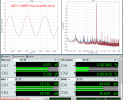I don't know if I agree that the Nad C320BEE would have any special sound character. Reading Amir's test it seems to amplify the signal without coloring the sound. Specified at 50 watts but in reality it has 67 watts. SINAD of 95 if used solely as a power amp. Good performance I must say.

The Nad C320BEE is now twenty years old, so it can in principle be considered vintage. Still good but of course could be in need of an overhaul, service given the age. Might be worth considering if you're thinking of buying a used Nad C320BEE.
There are probably a lot of good class AB amps in Nad's power class, which of course if they are the same age or older they may also need to be looked at,
from a service aspect that is.
The only advantage of new small cheap class D amps (Amir has tested loads of them) as I see it is that they are new, cheap and small. Fairly decisive reasons to buy such vs an older larger class AB amp.


As I see it, the disadvantage is with these small cheaper class D amps is that they are load dependent.
